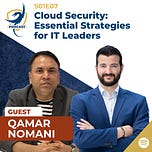In this conversation with Qamar Nomani, we discuss cloud security posture management (CSPM) and its benefits. Qamar shares his professional background and how he ended up writing a book on cloud security. They discuss the design and length of the book, as well as the key question of what CSPM is and its benefits. They also explore how CSPM fits into the broader cloud security ecosystem and the importance of cloud asset inventory in cybersecurity. They address the perception that cloud is less secure than on-premises and emphasize the shared responsibility model. Finally, they touch on compliance management and governance in the context of European directives. Cloud Security Posture Management (CSPM) tools help with compliance management by automating the process of checking and maintaining compliance with various standards and regulations. CSPM tools bring pre-built compliance benchmarks and engines, saving time and effort for engineers. They provide a dashboard and reports that show the organization's compliance score and highlight areas where improvements are needed. CSPM tools also assist in audits by allowing auditors to access masked assets and review controls and policies. Some major CSPM tools and vendors include Microsoft Defender for Cloud, Prisma Cloud, Orca, Sophos Optix, Wiz, Lacework, and Symantec CloudSOC.
CHAPTERS
(00:00) Introduction and Background
(03:03) Understanding Cloud Security Posture Management (CSPM)
(05:18) The Benefits of Cloud Security Posture Management
(09:17) Integrating CSPM into the Cloud Security Ecosystem
(19:04) The Importance of Cloud Asset Inventory in Cybersecurity
(25:05) Addressing the Perception of Cloud Insecurity
(29:02) Compliance Management and Governance in the Cloud
(32:06) Introduction to CSPM and Compliance Management
(36:42) CSPM Tools for Hybrid Cloud Environments
(39:53) Expanding Compliance Beyond IT Infrastructure
(48:49) DevSecOps and the Shift Left Approach
(54:29) The Future of Qamar Nomani











